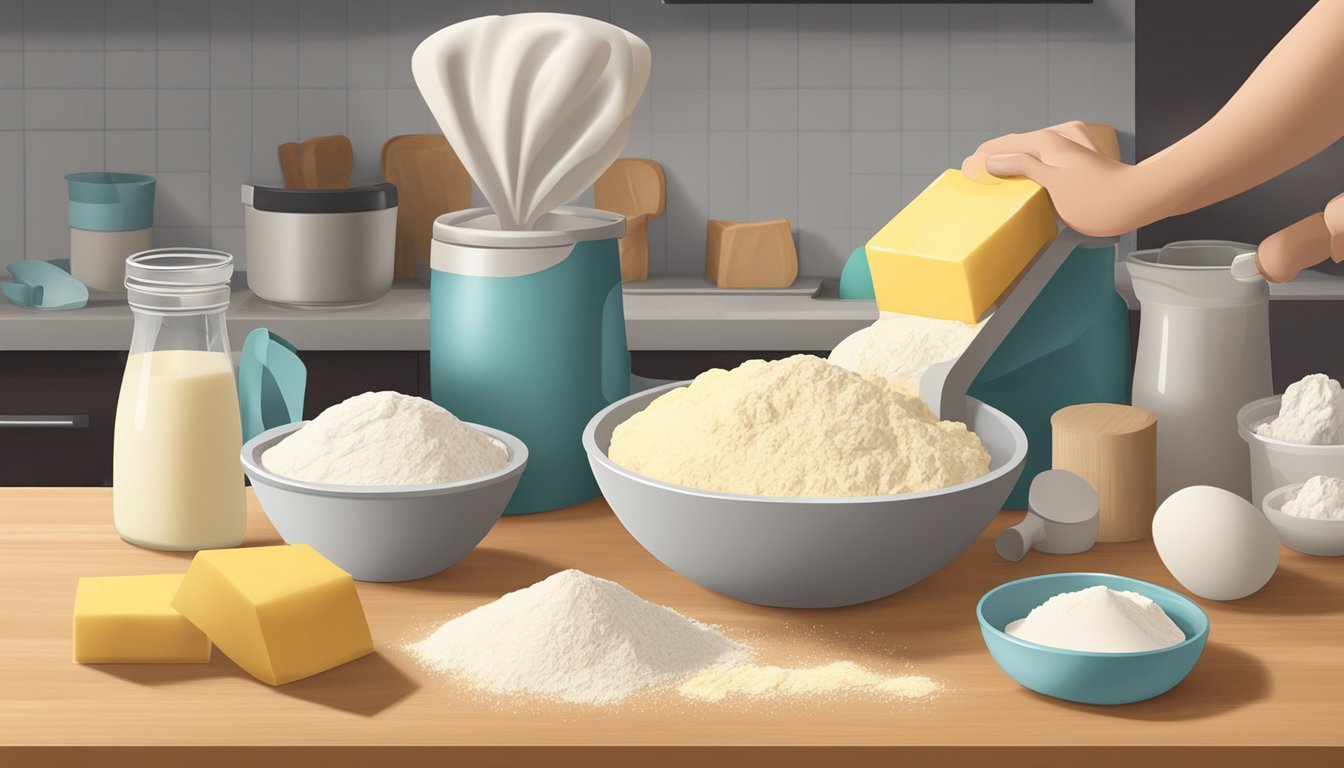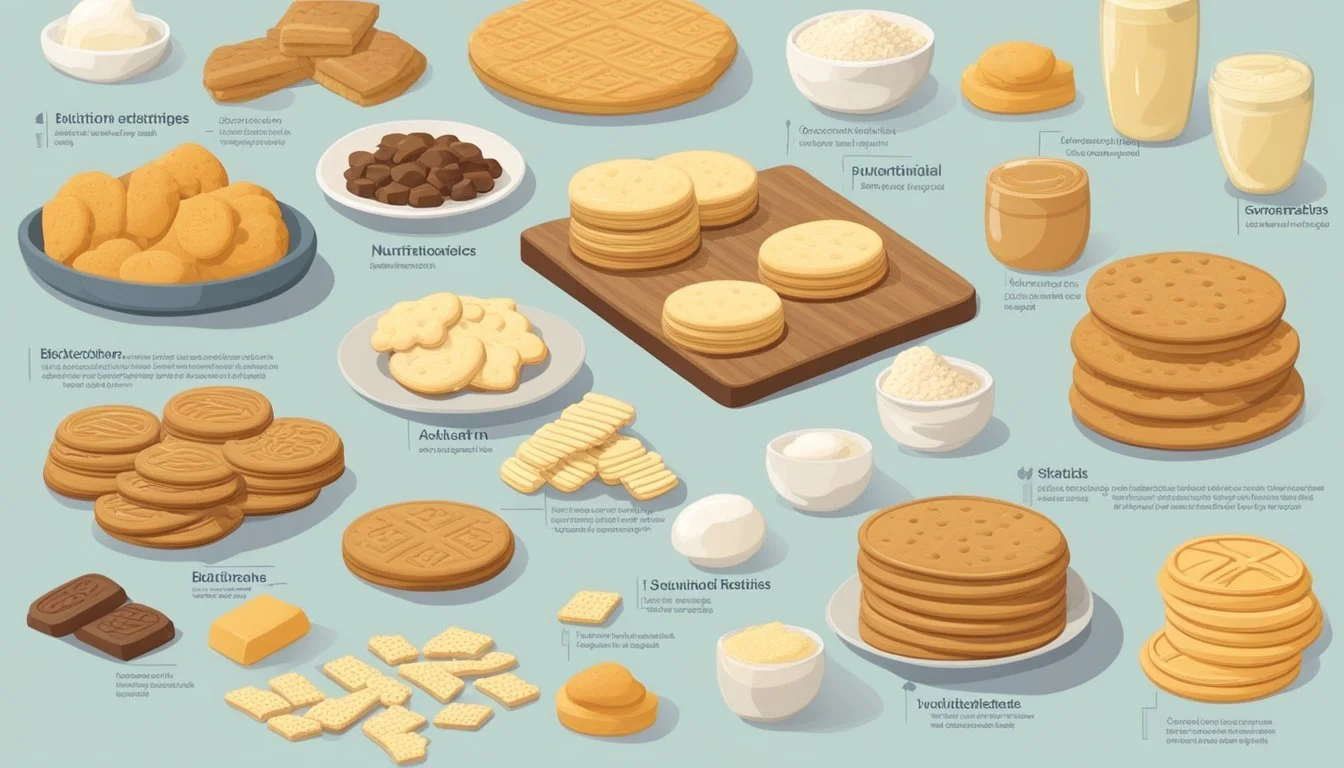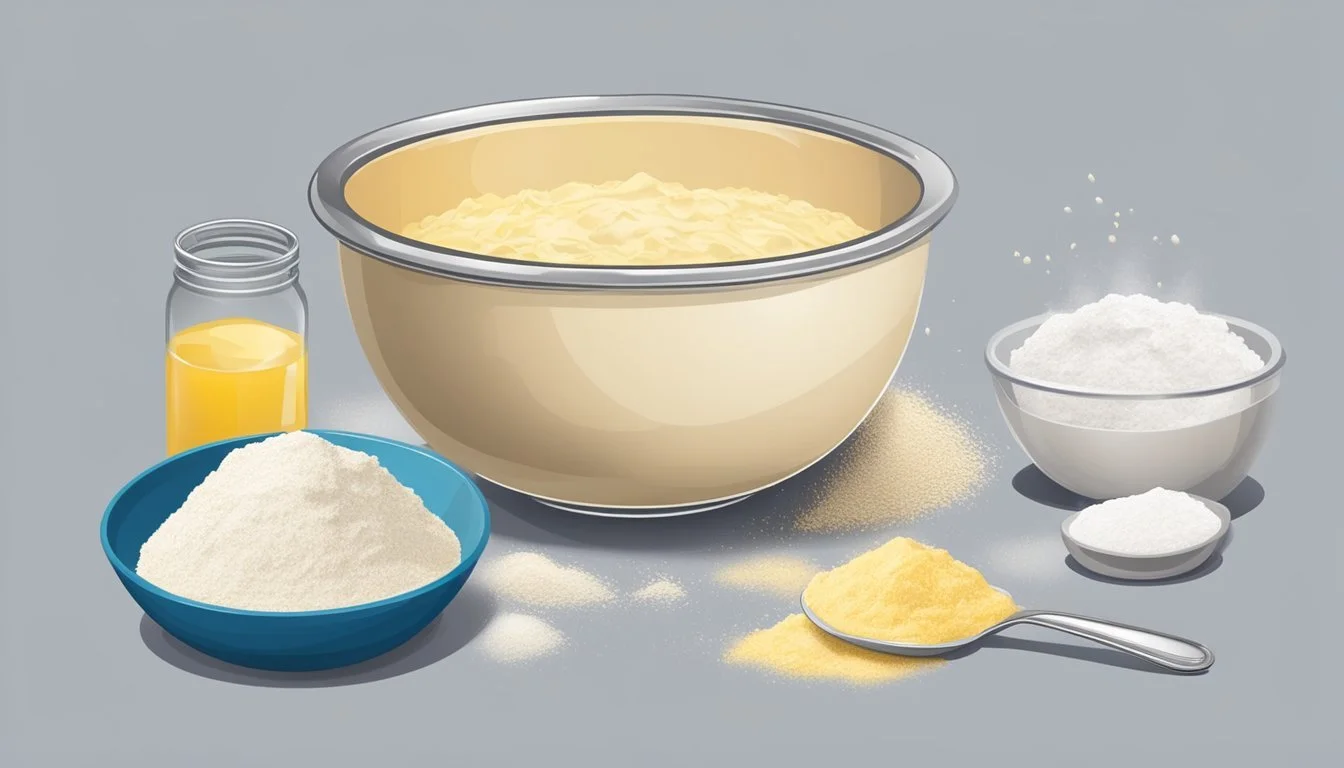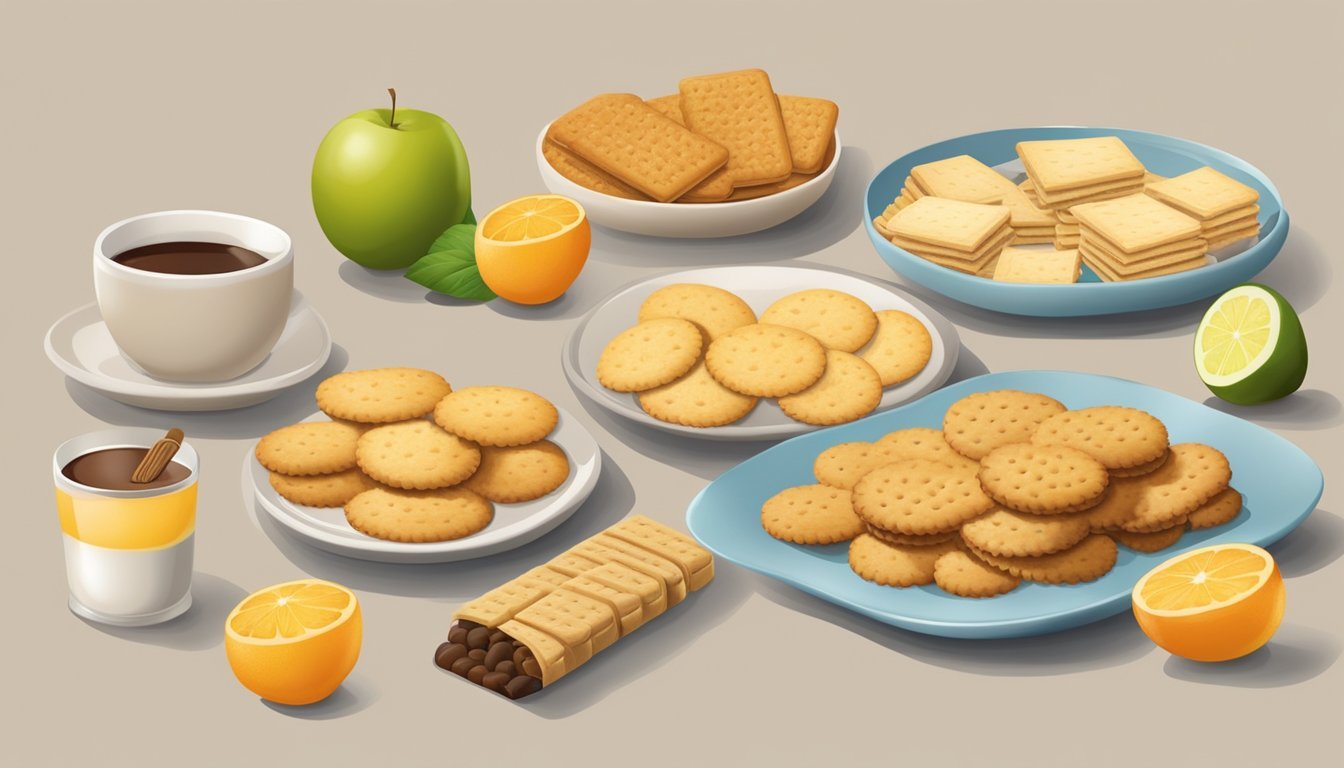Biscuit Substitutes
Healthy Alternatives for Your Snack Time
Biscuits hold a cherished place on dining tables worldwide, often accompanied by the welcoming aroma of buttery richness. From flaky layers to tender crumb, these baked delights are a versatile staple in many cuisines. However, with the increasing diversity of dietary needs and pantry staples, the traditional baking mix used for biscuits has seen a wave of substitutes. These alternatives cater to specific requirements, ranging from gluten-free options to low-carb solutions, ensuring that the joy of baking and savoring biscuits is accessible to all.
For those seeking to mirror the convenience and consistent results of the classic biscuit mix, there are numerous alternatives that can be found in most pantries. These substitutes not only adhere to various dietary preferences but also maintain the ease of preparation. Natural ingredients, such as almond and coconut flours, come into play for those on a ketogenic diet, while whole wheat and gluten-free flours provide options for those with gluten intolerance or seeking a fiber-rich diet. The ability to create homemade biscuit mixes using these components ensures that the resulting baked goods are tailored to individual health requirements without sacrificing flavor or texture.
Understanding Biscuit Ingredients
The quality and choice of ingredients can significantly affect the texture and taste of biscuits. Understanding the role of each ingredient is crucial in substituting them effectively.
Flour Types and Alternatives
Flour provides the structure for biscuits. All-purpose flour is a versatile choice with a moderate protein content, balancing strength and tenderness. Cake flour has a lower protein content and results in a more tender biscuit. For a healthier or gluten-free option, oats or almond flour can be used; however, these alternatives may alter the texture and flavor. Gluten-free flours blend various non-wheat sources to mimic the properties of wheat flour.
Leavening Agents Explained
Leavening agents are essential for adding lightness to biscuits. Baking powder, a complete leavening agent, contains both an acid and a base to react and produce carbon dioxide. Baking soda, on the other hand, requires the presence of an acid in the recipe to act. The correct balance of these agents ensures biscuits rise properly without an aftertaste.
Fats in Biscuits: Butter and Substitutes
Fats contribute to the flakiness and flavor of biscuits. Butter offers a rich taste but can be substituted with shortening for a more tender texture. Options like coconut oil and margarine can be used as well, especially for those with dietary restrictions. Regardless of choice, it is important that the fat is well-incorporated into the flour to achieve the desired layers in the biscuits.
Making Biscuits without Bisquick
In the pursuit of biscuit making without Bisquick, cooks can explore various substitutes ranging from homemade mixes to store-bought alternatives. These options cater to different dietary preferences, ensuring that delicious biscuits are accessible to all.
Homemade Baking Mix Recipes
For those who prefer a hands-on approach, creating a homemade baking mix is straightforward and can be made with common kitchen staples. A basic recipe includes all-purpose flour combined with baking powder and salt. To approximate the properties of Bisquick, for every cup of flour, one should mix in 1½ teaspoons of baking powder and a ¼ teaspoon of salt.
Basic Homemade Mix:
1 cup All-Purpose Flour
1½ tsp Baking Powder
¼ tsp Salt
Combine and use as needed
Gluten-free Alternatives
Individuals following a gluten-free diet can swap in a gluten-free flour blend in place of all-purpose flour. It is vital to ensure that the baking powder used is also gluten-free. Some store-bought options like Gluten-Free Jiffy Baking Mix or Krusteaz Gluten-Free Mix can serve as direct substitutes, offering convenience and reliability.
Store-Bought Gluten-Free Mixes:
Jiffy Gluten-Free Baking Mix
Krusteaz Gluten-Free Mix
Healthier Biscuit Options
To address the desires of a natural lifestyle or specific health requirements, there are mixes available that cater to these needs. For example, a Keto Biscuit Mix typically includes low-carb flours like almond or coconut and may incorporate protein into the blend. These specialty mixes often avoid GMO ingredients and use natural leaveners.
Keto Biscuit Mix Components:
Almond or Coconut Flour
Oat Fiber
Protein-enriched (optional)
Non-GMO, natural ingredients
Creative Biscuit Substitutes
Exploring biscuit substitutes can add a fresh twist to recipes and accommodate various dietary needs. This section outlines alternatives suitable for savory dishes, sweet creations, and special diets, ensuring flavorful results without compromising on taste or texture.
Savory Biscuit Alternatives
For savory applications, phyllo dough offers a flaky texture that pairs well with pot pies and casseroles. Cooks can use it to top savory dishes or create crusts. Pie crust is another option, known for its flaky finish that resembles traditional biscuit dough when the "roll, fold, and roll" technique is applied. Both substitutes require a light touch in handling to maintain their delicate layers.
Phyllo Dough: Layer for casseroles or savory turnovers
Pie Crust: Use for flaky toppers in recipes calling for a biscuit crust
Sweet Biscuit Alternatives
For sweet variations, home bakers can consider using cinnamon and sugar toppings on their biscuits to appeal to those who enjoy sweet flavors, like that of Cinnamon Toast Crunch cereal. Alternatively, digestive biscuits or graham crackers can serve as a base for dessert bars or as a crumbly addition to layered sweet treats. They can be crushed and mixed with butter to create a firm, sweet crust.
Cinnamon Sugar: A sweet topping for enhancing plain biscuits
Digestive Biscuits/Graham Crackers: Crush for dessert base or layering
Biscuit Substitutes for Special Diets
In catering to special dietary needs, rice cakes can be a low-calorie snack alternative to biscuits. With significantly less fat and sugar, they're suitable for those monitoring their calorie intake. For individuals seeking high-protein options, adding muffins made with protein-enriched flour or ingredients can be a satisfying biscuit substitute.
Rice Cakes: A low-calorie, low-fat, and low-sugar snack option
Protein-Enhanced Muffins: Incorporate protein flour for a nutritious substitute
Biscuit Substitutes in Cooking and Baking
When baking or cooking, selecting the right substitute can drastically affect the texture and flavor of the dish. This section explores the use of alternative binders, strategies for savory applications, and how to incorporate substitutes in desserts.
Alternative Binders for Baking
In place of traditional biscuit mix, one can use pancake mix or homemade alternatives combining flour, baking powder, and salt. To replicate the leavening effect in baked goods, a mixture of ¼ teaspoon baking soda with a half teaspoon of cream of tartar works as a functional replacement for baking powder. Remember, these substitutes may alter the final taste slightly.
Substitutes in Savory Dishes
For savory dishes like quiche or fried chicken, substitutes must complement the dish’s overall flavor profile. Jiffy Baking Mix and Krusteaz Baking Mix can replace Bisquick to create a flaky pie crust or a crunchy chicken exterior. Both options provide the necessary binding and structure while maintaining a neutral taste that doesn’t overpower the dish’s savory notes.
Dessert Application of Biscuit Substitutes
Desserts like peach cobbler, coffee cake, and cheesecake base can all benefit from biscuit substitutes. Use a biscuit mix substitute to create a crumbly, buttery streusel topping for coffee cakes or cobblers. For a cheesecake base, a blend of biscuit mix and butter can mimic the texture of a traditional graham cracker crust. Always measure accurately to ensure the proper balance between wet and dry ingredients for optimal texture.
Storing and Keeping Biscuit Substitutes
When incorporating substitutes such as vegetable oil, coconut oil, or melted butter into your homemade biscuit mixes, proper storage is key to maintaining freshness and extending shelf life.
Optimal Storage Conditions
To store biscuit substitutes effectively, one should use an airtight container to prevent the ingredients from absorbing moisture or odors. Substitutes like coconut oil and melted butter should be kept in a cool, dark place, possibly within a glass jar or a sealed plastic container. Ingredients should be placed away from direct sunlight, as exposure can lead to spoilage.
For substitutes in powder form produced with a food processor, like a mix of flour and hydrogenated oil or vegetable shortening, storage in a dry pantry is ideal. Dry mixes can also benefit from refrigeration, especially if they contain fat which can go rancid at room temperature over time.
Shelf Life Considerations
Different biscuit substitutes have varying shelf lives:
Vegetable oil: Store in a cool, dark place and use within 6 to 12 months.
Coconut oil: Has a longer shelf life and can last up to 2 years if stored properly.
Melted butter: Should be refrigerated and ideally used within a month.
Vegetable shortening: Can last up to a year in the pantry, but check for signs of spoilage.
For homemade biscuit mixes that serve as pantry staples, they should be used within 3 to 4 months when kept in the fridge in an airtight container. Freezing can extend this period significantly, but one should always label the container with the date to keep track.
Nutritional Information and Dietary Considerations
In evaluating biscuits and their substitutes, consumers should consider the caloric content, balance of macronutrients, and the presence of essential vitamins and minerals. These nutritional factors are pivotal for individuals who may be managing dietary needs, maintaining a natural lifestyle, or are physically active like running.
Caloric Content of Substitutes
Biscuit substitutes can vary significantly in calories. Traditional biscuits primarily made from refined white flour, fat, and granulated sugar may contain higher caloric counts. Substitutes often utilize ingredients such as tapioca starch and gluten-free Bisquick mix, which can lower the calorie density while still providing a satisfactory product.
Examples:
Tapioca Starch: Lower in calories compared to traditional flour.
Gluten-free Bisquick Mix: Can be less dense in calories due to alternative flour blends.
Balancing Macronutrients
One can find diverse macronutrient profiles within biscuit substitutes. It is not uncommon for substitutes to attempt a reduction in saturated fat, cholesterol, and sodium content. Ingredients like xanthan gum may be used to replace gluten and affect the texture without greatly altering macronutrient balance. Substitutes also aim to provide a favorable balance of macronutrients, emphasizing protein for satiety and muscle repair, particularly beneficial for those with an active lifestyle.
Considerations:
Protein Content: Higher in some fortified biscuit substitutes.
Sodium and Salt: Often reduced in healthier alternatives to manage heart health.
Vitamins and Minerals in Substitutes
When considering vitamins and minerals, substitutes may enrich their products with essential nutrients such as calcium, iron, and potassium to address dietary needs. While traditional biscuits might not be a significant source of these nutrients, fortified substitutes seek to offer more nutritionally dense options.
Nutrient Profiles:
Calcium: Sometimes added to improve bone health.
Iron: Fortified in some substitutes to prevent anemia.
Potassium: Included in certain recipes to support muscle and nerve function.
Tips and Tricks for Biscuit Substitute Preparation
When preparing biscuits with substitutes, precision in ingredient selection, alteration of techniques, and following specific cooking directions are crucial. These modifications help maintain the quality and taste of the biscuits.
Working with Gluten-free Mixes
To create gluten-free biscuits, one should choose a gluten-free baking mix that includes ingredients such as xanthan gum to mimic the binding properties of gluten. It is important for the chef to maintain the balance between wet and dry ingredients to prevent the dough from being too sticky or crumbly.
Proportion: Stick to a 1:1 substitution ratio when replacing regular flour with a gluten-free baking mix.
Extra Moisture: Consider adding slightly more liquid as gluten-free flour can be drier.
Achieving Desired Textures
The key to achieving flaky, soft textures in biscuits lies in the manipulation of fats and leavening agents. Use cold fats and work them into the dry ingredients until the mixture resembles coarse crumbs.
Cold Butter: Incorporate cold, cubed butter using a pastry cutter or forks to maintain the right texture.
Baking Powder: Ensure fresh baking powder is used for optimum rise.
Cooking Directions for Best Results
Follow specific cooking directions closely to yield the best results with biscuit substitutes. Preheat the oven to the correct temperature as uneven cooking temperatures can lead to improperly baked biscuits.
Preheat: An oven must be preheated to between 425°F and 450°F for buttermilk biscuits.
Timing: Biscuits usually take 12 to 15 minutes to bake. However, it's essential to watch the biscuits as oven heat may vary.
By sticking to these specifications, one can confidently prepare biscuits using substitutes without sacrificing taste or texture.
Conclusion
In the realm of baking, the art of creating biscuits stands as a testament to culinary ingenuity. When traditional tools are absent, one's adaptability is key. Resourcefulness in the kitchen can lead to the utilization of alternative items like an upside-down cup or glass to shape biscuits, reflecting a holistic approach to a natural lifestyle and cooking.
The journey of biscuit-making, whether guided by family recipes or a professional baking mix, emphasizes the importance of pantry staples. These ingredients not only anchor the biscuit's texture and flavor but also inspire creative solutions. Substituting a biscuit cutter with a kitchen knife demonstrates that ordinary objects have multiple functions when viewed through a lens of innovation.
The conveyance of this wisdom is akin to a train of thought shared among baking enthusiasts, each car loaded with tips and tricks, steadily chugging towards a destination of delectable results.
Kitchen Substitutes Biscuit Qualities Upside-down cup/glass Uniform shape Kitchen knife Sharp, clean edges
They should embrace these strategies confidently, knowing that the integrity of their biscuits will remain intact. In sum, cooking is an adaptable journey—one that encourages a pragmatic and astute approach, integrating the essence of a natural lifestyle into every bite.








